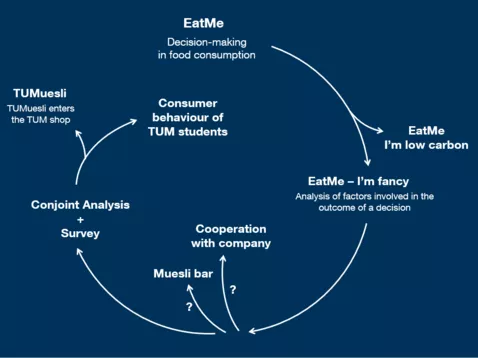EatMe, I'm fancy!
Project

Buying food is an everyday activity involving many decisions. We have never had so many options and possibilities when choosing our food as we do nowadays. Which factors play a key role when it comes to the final decision? The aim of our project is to analyze this question by concentrating on the muesli consumption of students at TUM. Using a “conjoint analysis,” we were able to gain an insight into the priorities governing the choice of ingredients for making muesli specifically in relation to the categories of regionality, price, nutritional value, and organic certification. The results show some surprising characteristics and these should be of interest and relevance to further studies in this area.
Goals
We decided to analyze the decision-making processes concerning food consumption in depth from theoretical and practical perspectives, due to the high topicality and future relevance of this subject. Therefore, a set of rational criteria, leading to a certain outcome, were defined and their importance was studied. For our analysis, we decided to concentrate on one specific foodstuff to allow for a precise investigation. Ideal targets are simple products which enable the consecutive variation of different parameters to determine the analyzed factors. After intensive research, we opted for muesli as our food of interest. Apart from being consumed among many different potential target groups in Germany, muesli is a composite foodstuff composed of several ingredients, thus enabling the separate investigation of each decision made when choosing each of these. With muesli, therefore, we were able to analyze many decisions while focusing on just one product. To allow for a more precise analysis of our initial question and to control the comparability of results, we decided to focus on a particular target group: students at TUM. This choice was determined not only by the fact that the latter represented an easily accessible group for us, but also by the high degree of heterogeneity of sociocultural background among TUM students.
Methods
The selection of a suitable method for our research involved a long process, led by practical considerations and studies on questionnaire-answering and self-assessment. To determine the most important decision-making factors, several approaches were discussed, such as the use of a questionnaire, a virtual model simulation, and an econometric model. Problems occurring in research fields when participants were asked to state their opinion on ethical topics have been described in the relevant literature. If participants are asked directly whether they prefer a more expensive fair-trade product over a cheaper conventional one, most will state their willingness to buy the fair-trade one. The participants feel obligated to do so, even though they would behave differently in real life. Thus, it is better to ask questions in which such ethical statements get rouged. A method to do this is the conjoint analysis which aims to measure the importance of individual factors without overtly asking about them, while still trying to resemble a realistic decision.
Team Members
- Maximilian Hechler
- Carolin Klose
- Sebastian Laumer
- Sophie Petersen
- Carlos Piedrafita Alvira
- Lukas Raith
- Konstantin Wolf
Tutors
- Dominik Irber
- Josef Oberndorfer
Mentor
- Dr.-Ing. Johannes Petermeier
